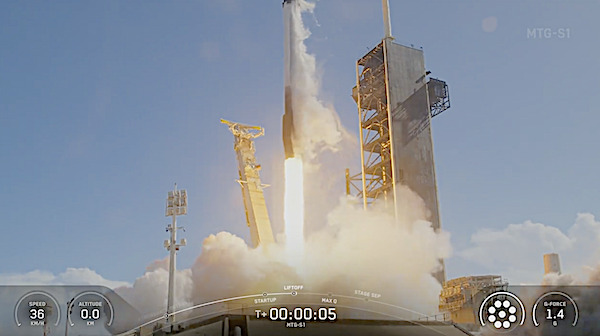
On Tuesday, July 1 at 5:04 p.m. ET, Falcon 9 launched the Eumetsat MTG-S1 mission to geosynchronous transfer orbit from Launch Complex 39A (LC-39A) at Kennedy Space Center in Florida.
Both MTG and Copernicus Sentinel-4 are world-class Earth observation missions developed with European partners to address scientific and societal challenges, such as air pollution and extreme weather events. While the MTG-Sounder (MTG-S1) will provide improved data for weather forecasting and storm detection, Sentinel-4 will enhance air quality monitoring over Europe.
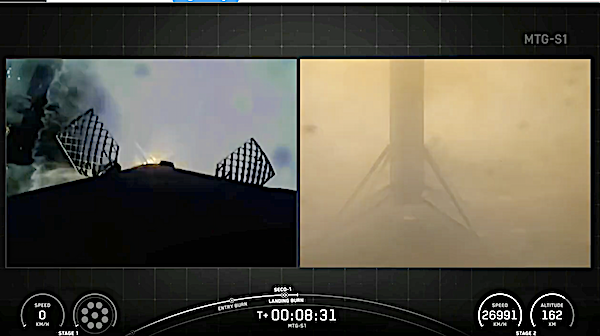
This was the ninth flight for the Falcon 9 first stage booster supporting this mission, which previously launched Crew-9, RRT-1, Firefly Blue Ghost Mission 1, Fram2, SXM-10, and three Starlink missions.
SpaceX’s Falcon 9 to launch MTG-Sounder satellite July 1st
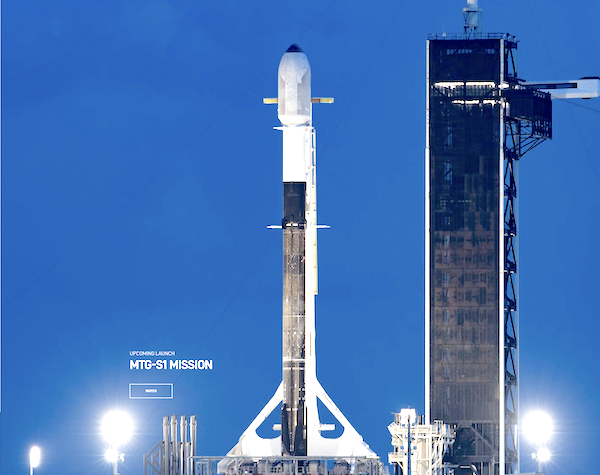
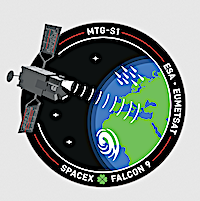
SpaceX is targeting Tuesday, July 1 for a Falcon 9 launch of the Eumetsat MTG-S1 mission to geosynchronous transfer orbit from Launch Complex 39A (LC-39A) at Kennedy Space Center in Florida. The 150-minute window opens at 5:04 p.m. ET. If needed, a backup launch opportunity is available on Wednesday, July 2 at the same time.
A live webcast of this mission will begin about 15 minutes prior to liftoff, which you can watch on X @SpaceX. You can also watch the webcast on the new X TV app.
This will be the ninth flight for the Falcon 9 first stage booster supporting this mission, which previously launched Crew-9, RRT-1, Firefly Blue Ghost Mission 1, Fram2, SXM-10, and three Starlink missions. After stage separation, the first stage will land on the Just Read the Instructions droneship, which will be stationed in the Atlantic Ocean.
Launch Complex 39A has witnessed the launch of 209 rockets, including 208 orbital launch attempts. While Kennedy Space Center, Florida, has been the site for 267 rocket launches.
The John F. Kennedy Space Center, located on Merritt Island, Florida, is one of NASA’s 10 field centers. Since 1968, KSC has been NASA’s primary launch center of American spaceflight, research, and technology. Launch operations for the Apollo, Skylab and Space Shuttle programs were carried out from Kennedy Space Center Launch Complex 39 and managed by KSC. Located on the east coast of Florida, KSC is adjacent to Cape Canaveral Space Force Station (CCSFS).
ESA’s comments as MTG-S1 and Sentinel-4 are ready for launch Tuesday
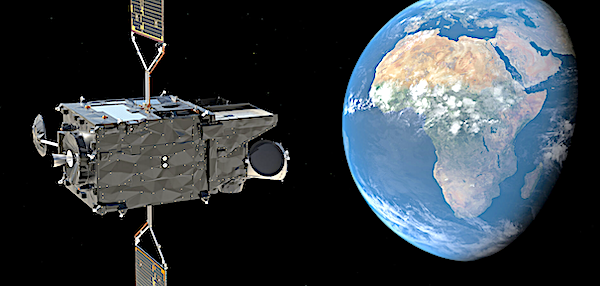
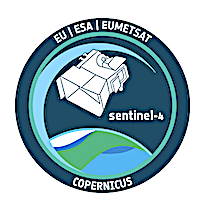
The second of the Meteosat Third Generation (MTG) satellites and the first instrument for the Copernicus Sentinel-4 mission are ready for liftoff at Cape Canaveral in Florida, US. Live coverage of this launch will be shown on ESA WebTV, on Tuesday, 1 July.
The live coverage is scheduled to start at 21:15 CEST. Launch with SpaceX on Falcon 9 is expected at 23:03 CEST.
Both MTG and Copernicus Sentinel-4 are world-class Earth observation missions developed with European partners to address scientific and societal challenges, such as air pollution and extreme weather events. While the MTG-Sounder (MTG-S1) will provide improved data for weather forecasting and storm detection, Sentinel-4 will enhance air quality monitoring over Europe.
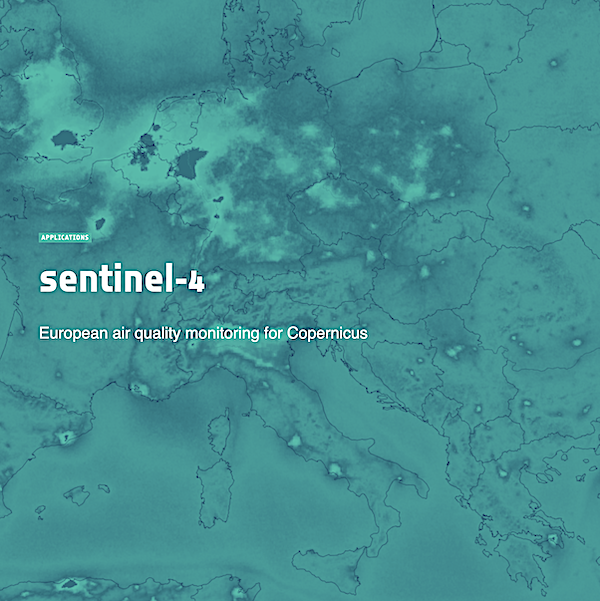
About MTG-S1
The MTG mission already has one satellite in orbit — the MTG-Imager (MTG-I) — so MTG-S will be the second MTG satellite to launch. Its Infrared Sounder uses interferometric techniques to capture data on temperature, humidity, wind and trace gases that are used to generate 3D maps of the atmosphere, improving the accuracy of MTG’s weather prediction.
The Infrared Sounder will be the first hyperspectral sounding instrument placed in geostationary orbit by a European-led mission. It will be positioned about 36,000 km above the equator and will maintain its position relative to Earth, following the same area on the planet’s surface as we rotate. It will provide coverage of Europe and part of northern Africa on a repeat cycle of 15 minutes, providing meteorologists with a complete weather picture of the region, complementing data on cloud formation and lightning from MTG-I.
About Copernicus Sentinel-4
The MTG-S satellite hosts the Copernicus Sentinel-4 mission by carrying the ultraviolet, visible, near-infrared light (UVN) spectrometer that captures data every hour to monitor air quality and pollution, also over Europe and northern Africa.
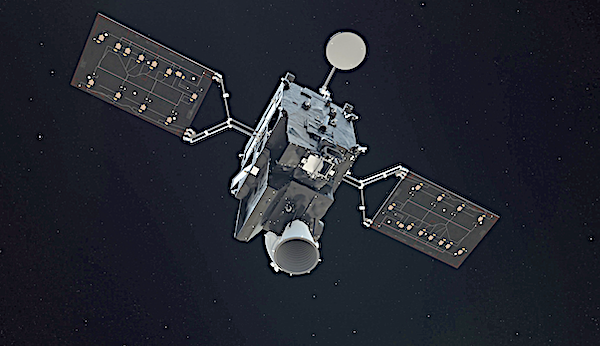
The spectrometer delivers high-resolution data on gases that affect the quality of the air we breathe, including a wide range of atmospheric trace gases and pollutants such as nitrogen dioxide, ozone, sulphur dioxide and formaldehyde.
Thanks to its fixed position in geostationary orbit on board MTG-S, Sentinel-4 will be able to deliver data every 60 minutes during daylight to support the Copernicus Atmosphere Monitoring Service for rapid forecasting. The mission will complement the Sentinel-5 and Sentinel-5P missions, which provide daily observations of the Earth from their polar orbits.
Sentinel-4 is the European contribution to the global constellation of geostationary air quality sensors. It will work alongside the Korean sensor Gems, observing air pollution over Asia, and NASA sensor Tempo, measuring air pollution over North America.
Thales Alenia Space was the prime contractor for the overall MTG mission, with OHB Systems responsible for the MTG-Sounder. The prime contractor for Sentinel-4 is Airbus Defence and Space. Mission control and data distribution for both MTG-S and Sentinel-4 will be managed by Eumetsat.
EUMETSAT’s Meteosat Third Generation Sounder 1 (MTG-S1) satellite will make a crucial contribution
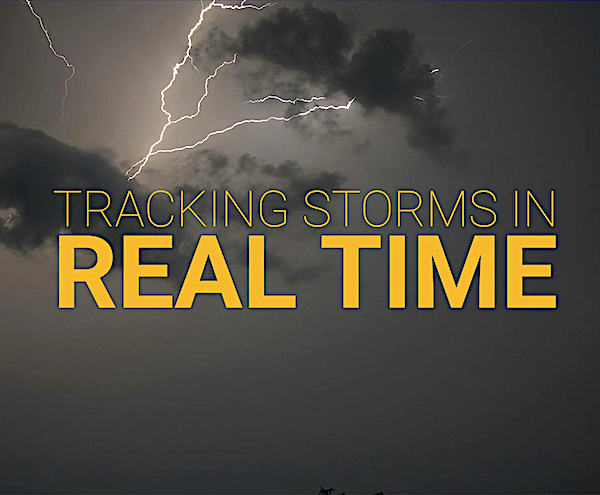
Set to be launched this July, the Meteosat Third Generation Sounder 1 (MTG-S1) satellite will make a crucial contribution to doing just that. The first European satellite in geostationary orbit to carry a hyperspectral sounder, its instruments will complement those of the first satellite in the MTG fleet, Meteosat-12.
Once in orbit, these two MTG satellites will follow the Earth as it rotates, remaining in their shared orbital slot about 36,000km above where the equator cuts through the Gulf of Guinea, off the west coast of Africa. By sharing an orbital slot — a technique known as colocation — the observations collected by the instruments on each platform will be as though from the same platform. Together, these instruments will provide data that will enable meteorologists to level up their forecasting of severe storms.
“Before MTG, some part of the picture of the development of a storm was missing,” said Dr. Jochen Grandell, EUMETSAT’s MTG Programme Scientist.
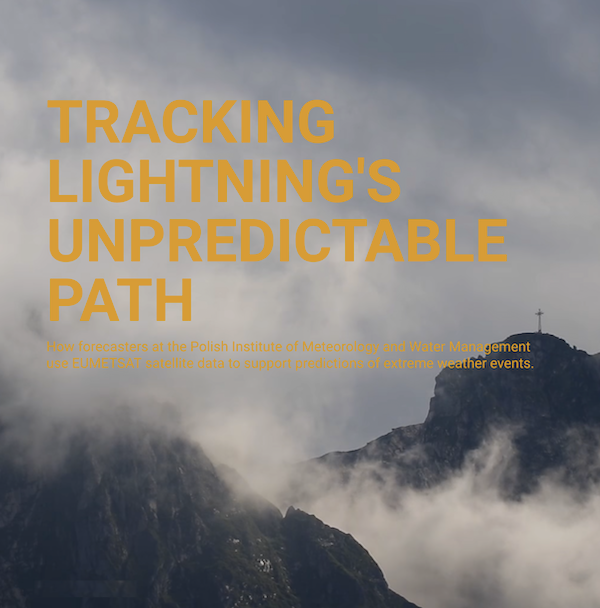
“For example, we saw the growing clouds, however, we did not see the early lightning, which indicates a storm’s severity. Now, meteorologists will be able to receive observations for the whole life cycle of a storm using data from MTG instruments together.”
The initiation of severe thunderstorms hinges on atmospheric instability — an overlap of low-level humidity and strongly decreasing temperature with increasing height — combined with lift caused by a convergent wind field or mountain range.
“As of now, this developing instability cannot be followed by measurement data,” said Alois Holzer, Director of Operations at the European Severe Storm Laboratory.
“Currently, the only way of observing the Earth’s atmosphere in certain regions is by using in-situ instruments such as weather balloons and probes attached to aircrafts — without them, there is simply no way of observing what is happening above the surface. Forecasters can rely on models for guidance but cannot follow the conditions with measured data to see if things are developing as expected. That is what is so exciting about the new sounder satellite — for the first time, it will be possible to closely follow how the atmosphere prepares itself for a thunderstorm.”
The 4D weather cube, depicted in the animation below, is a valuable tool for visualising the complementarity of four different data sets — atmospheric profiles, winds, convection, and lightning — from three key MTG instruments…more
Article by author Sarah Puschmann continues.
